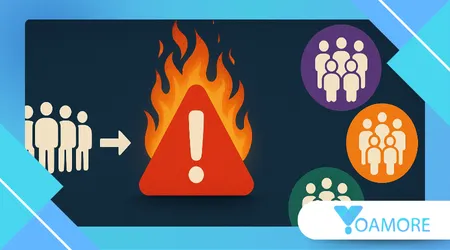The Invisible Power of Microcultures in the Digital Age

Microcultures are emerging as true driving forces in the dynamic digital landscape we observe in 2025. They represent the fragmentation of mainstream culture into smaller, ultra-segmented groups, connected by very specific interests, passions, or identities.
Anúncios
Understanding the rise and influence of these communities is crucial for anyone navigating or seeking to thrive in this constantly evolving ecosystem.
🗺️ Summary
- What are Microcultures and Why Have They Become Essential?
- What is the Real Impact of Microcultures on Consumer Behavior?
- How Can Brands Authentically Connect with These Niches?
- What are the Risks of Ignoring the Strength of Microcultures in Digital Marketing?
- Frequently Asked Questions (FAQs).
Anúncios
🎯 What are Microcultures and Why Have They Become Essential?
Have you ever stopped to consider how the digital world has allowed us to find our “tribe,” no matter how peculiar it might be?
Microcultures are precisely this: small groups of people who unite around a niche interest, an obscure hobby, a particular ideology, or a very specific lifestyle. They thrive thanks to digital tools that transcend geographical barriers.
The essence of modern communication lies in hyper-connection and the search for authentic belonging, something that mass culture can no longer offer.
These communities are not just seeking content; they seek validation, a safe space to express their identity and passions without the judgment of the general public. It’s a powerful movement from the inside out.
They have become essential because attention, the scarcest resource on the internet, is shifting toward these intimate and engaging environments.
Where large platforms once dominated, we now observe the rise of specialized forums, private groups, and ultra-niche thematic channels. These groups create their own codes, languages, and references, making the engagement much deeper.
The cultural anthropologist Margaret Mead once said, “Never doubt that a small group of thoughtful, committed citizens can change the world; indeed, it’s the only thing that ever has.”
This quote remains incredibly relevant when applied to the digital context. Observe the power of social movements, consumer trends, and linguistic changes born within these small virtual circles.
This reality challenges the traditional marketing model, which targeted large audiences with generic messages, demanding a more surgical approach.
The companies that are thriving today are those that demonstrate understanding and respect for the uniqueness of each microculture. Understanding this scenario is the first step toward any effective digital strategy.
+ Rural Welsh Choirs and the Culture of Communal Singing
💰 What is the Real Impact of Microcultures on Consumer Behavior?
Consumer behavior has been rewritten by the logic of microcultures, shifting from the search for popularity to the pursuit of authenticity and relevance.
Consumers are no longer satisfied with following major trends imposed by distant celebrities or large corporations. They prefer to trust micro-influencers and peers within their chosen microculture.
The purchasing decision is deeply influenced by social endorsement coming from within the niche itself, where credibility is worth much more than reach.
This means that a product or service, if validated by its microculture, gains organic traction and an almost unwavering loyalty. The power of propagation is immense, quickly turning a niche into a trend.
A notable example is the growth of sustainability and conscious consumption niches, where communities dedicated to a zero waste lifestyle drive smaller, ethical brands.
These groups meticulously seek the veracity of information, rejecting greenwashing with a fervor that only a sense of community provides. They don’t just buy products; they acquire an extension of their group identity.
The table below illustrates the shift in focus for digital marketing, highlighting the value of segmented groups in 2025:
| Marketing Strategy | Primary Focus | Type of Engagement | Message Credibility |
| Mass Marketing | Broad Audiences | Superficial and Volatile | Low (Perception of Advertising) |
| Niche/Microculture Marketing | Segmented Groups | Deep and Loyal | High (Peer Endorsement) |
Consumer loyalty is the new battleground, and microcultures are the safest fortress. Conversion rates and Customer Lifetime Value (LTV) within these niches tend to be significantly higher.
This fact is due to the deep emotional connection and identification that people develop with a brand that respects their microculture.
+ Pop Linguistics: How Pop Music is Influencing Vocabulary Worldwide
🤝 How Can Brands Authentically Connect with These Niches?

Connecting with microcultures requires humility, active listening, and a mindset shift from “selling” to “participating.” Brands must stop shouting messages and instead learn to whisper in the tone and language appropriate to that group. Authenticity is not a tactic, but a prerequisite for entry into these exclusive spaces.
First, it is essential to invest in deep research to map the microcultures relevant to your brand, understanding their rituals, jargon, and undeclared values. Do not try to impose your corporate culture; strive to adapt your message to the existing ecosystem.
An effective strategy lies in genuine collaboration with the leaders and content creators within these microcultures.
Instead of hiring mega-celebrities, seek passionate specialists with 5,000 followers who are undisputed references within the niche. They carry the banner of credibility.
In a recent report, Gartner revealed that 75% of corporate data will be processed outside traditional data centers by 2025, underscoring the importance of more decentralized solutions.
This technological decentralization is accompanied by cultural decentralization, showing that power is no longer in a single point, but in multiple sources.
The brand should act as a facilitator or catalyst, providing tools, support, or platforms that help the microculture flourish, without attempting to control it.
Creating products or limited editions that meet the ultra-specific needs of the group is a demonstration of respect.
It is crucial that all communication reflects a deep knowledge of the internal codes of the microculture. Using an outdated meme or a poorly deployed slang term can be enough for the brand to be instantly rejected. Precision in communication is the key to success.
⚠️ What are the Risks of Ignoring the Strength of Microcultures in Digital Marketing?
Ignoring the growing power of microcultures in the 2025 landscape is a strategic mistake that can lead to digital invisibility and market irrelevance.
When the audience seeks niche and you offer mass, the misalignment is immediate and the rejection is almost certain. Consumers do not have time for brands that do not understand them.
The main risk is the loss of authority and trust. In a world where information is vast, consumers rely on their groups to validate choices, and a brand that is not cited or endorsed within these circles simply does not exist for them.
This compromises the foundation of E-A-T (Expertise, Authoritativeness, Trustworthiness) in the digital world.
Lack of involvement with these niches causes the brand to lose valuable insights into market evolution and emerging trends, as innovations and behavioral changes are born within microcultures. Staying out means reacting instead of leading.
Another substantial danger is the waste of marketing investment, as high-reach, low-segmentation campaigns yield diminishing returns. Money spent on generic advertising could be directed toward high-impact, surgical actions.
According to the Brazilian Association of Electronic Commerce (ABComm), e-commerce in Brazil is expected to generate R$ 234 billion in 2025, driven by an average ticket of R$ 539.28 and three million new buyers.
This exponential growth happens in niches, not in vast segments, proving that purchasing power is segmented.
Many companies fail when trying to “hack” authenticity, simulating engagement without a real commitment to the values of the microculture. The result is a quick and corrosive backlash, as the digital community detects inauthenticity from miles away. You need to be a part, not just an observer.
The most important lesson is that the new attention economy demands focus and depth, and the invisible power of microcultures can no longer be underestimated.
These communities are the future of engagement and loyalty in the digital age. To delve deeper into this topic, explore articles and research on niche consumption, such as what can be found in this detailed study on e-commerce trends and market segmentation: ABComm Data and Current Scenario.
✅ Conclusion: The Strategic Turning Point
The journey to understand and interact with microcultures is fundamentally a journey of humanizing your brand. We leave behind the era of massive broadcast communication and embrace the moment of dialogue within groups.
Those who recognize the complexity and richness of these underrepresented communities will reap the rewards of genuine loyalty.
Success in the digital world in 2025 depends on your ability to move with the subtlety of a cultural curator, not the brute force of a corporate giant.
Honoring the specificity of each microculture is not just a smart marketing strategy, but an imperative for building a resilient brand. The real power is in the invisible, in the groups you barely see, but that move the market.
The best way to navigate this new landscape is to demonstrate respect and knowledge, ensuring that your brand becomes a valuable asset, and not an intrusion, in the daily life of the microculture.
For further reflections on the power of teamwork and collaboration, which echo the importance of smaller communities, you can visit: Quotes on Teamwork and Collaboration.
❓ Frequently Asked Questions (FAQs)
1. How does a brand identify a relevant microculture for its products?
Effective identification requires advanced social listening tools and human analysis to go beyond superficial data. Search for niche terms, ultra-specific hashtags, forums, and closed discussion groups related to your industry. Observing the group’s language, memes, and internal rituals reveals relevance.
2. What is the difference between microcultures and subcultures?
Subcultures are generally large groups that distinguish themselves from the dominant culture (e.g., Goths, Hip-Hop).
Microcultures are even smaller, more specific, and often more volatile fractions, quickly emerging in digital environments due to a hyper-niche interest (e.g., custom keycap collectors for mechanical keyboards). The main distinction is the degree of specificity and the size of the community.
3. Are Microcultures just passing fads?
Not necessarily. Although some microcultures may be ephemeral, many solidify into lasting passion communities.
The key is that the core interest is stable (e.g., video games, vegan cuisine), while the format or platform may change (e.g., from Reddit to Discord). The value lies in belonging, which is a persistent human need.
4. Do small brands have an easier time connecting with microcultures?
Yes, generally. Smaller brands have the advantage of agility and inherent authenticity, being perceived as less “corporate” and more “people.” They can position themselves as part of the microculture or as direct supporters, which is much more difficult for large companies with multiple interests.
5. Which metric is most important for evaluating success in a microculture?
The most crucial is depth of engagement, outweighing vanity metrics like reach. Monitor detailed comments, unsolicited mentions of the brand in private groups, the creation of User-Generated Content (UGC), and the overall sentiment of the community towards your brand. The quality of interaction surpasses the quantity.
